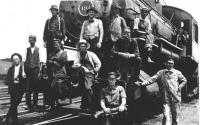
Serving the Vermont Champlain Valley Area for 45 Years
Main SectionsFront Page SportsValley VitalsIt's in the StarsStarwiseArchivesLinksAbout The VoiceContact Us |
The Bristol Railroad: The Little Train That Could
Tuesday September 18, 2007 By Larry Johnson For thirty-eight years, from 1892 until 1930, a steam engine huffed and puffed along the six -mile Bristol Railroad, from New Haven Junction to its home in Bristol Village. It was one of the shortest railroads ever built in Vermont, but it put Bristol on the map and gave that mountain town a commercial and cultural connection to the rest of the world. Railroad fever started in the 1880s, but it wasn’t until 1890, when a New York consortium of financiers offered to help pay for the building of the railroad, that the project finally found traction. The local towns, including Lincoln and Bristol, were responsible for raising part of the construction funds, and the town of Bristol voted on the bond issue on March 15, 1890. Out of 385 votes cast that day, only 33 citizens voted against the railroad. In July of that year, Bristol and Lincoln conferred with the New York financiers and it was unanimously decided that the Bristol Railroad would be up and running by November. By August, construction contracts had been awarded and the workers had begun leveling the rail bed. Sixty teams of horses and 150 men were on the job. It was believed that Thanksgiving Day would see the first run but, alas, this was not to happen. Soon the project began to run out of funds and the work began to slow down. By spring it was realized that there were insufficient monies to finish the job, and, as a result, there were a lot of long faces in Bristol that year. Grass and weeds began to recapture the road bed and the whole project seemed doomed. However, a new financial base was formed in 1891, and new life was pumped into the Bristol Line. Percival Clement of Rutland, a local banker and a major stock holder in the Rutland Railroad, agreed to finish financing the project if the citizens of Bristol would build the freight and passenger depots. By mid-November, the rails had been laid by the nearly 200 Italian construction workers that Clement had hired, and, on November 25th, the first- ever, rail- freight- run made its way down the mountain, from Bristol to New Haven Junction. A New Year’s Day celebration was predicted but a snow storm foiled the festivities. But on January 5, 1892, a passenger train started from Bristol and, 30 minutes later, connected with the Rutland Railroad in New Haven. Coming back up the mountain with its 60 passengers proved problematic for the small engine and it was decided that a larger engine was needed. One was ordered from the Rhode Island Locomotive Works. In February of 1891, the new engine, the 65 ton number 2731, arrived in Bristol from Providence. Number One, as she was referred to by Bristolites, was unusual in that she had a cow- catcher on both ends. Turning the engine around for the return trip from New Haven wasn’t convenient, so Number One negotiated the return trip to Bristol in reverse. Backing its way up the mountain was no problem for the Little Engine That Could. The Bristol Railroad was instrumental in elevating Bristol’s prestige. The population rose and so did property values. The local farmers in Lincoln and Starksboro finally had a way to get their produce to the larger markets, and so did the loggers. In 1895 alone, 225 carloads of potatoes left the freight yard in Bristol for Boston. During the winter months, coal stoves were kept fired in the freight cars in order to keep the potatoes from freezing while enroute. Between 1892 and 1930, when the railroad closed, the typical cargo on the line “consisted of lumber, coffins, potatoes, and maple syrup. Imports were mainly coal and manufactured goods for farmers and area residents.” A mail service was also part of the mix. Whatever the little Bristol Railroad was able to do for farmers and loggers, it did even more for local manufacturing. The railroad was a boon to The Bristol Manufacturing Company. This coffin factory had 150 employees and was shipping upwards of 75 coffins at a time, entire carloads, during the company’s heyday. Commerce is the engine that drives the financial well-being of any community, but entertainment is the cultural life-blood. And the “Bristol” as the railroad was affectionately referred to, brought all kinds of entertainment to Bristol and the surrounding towns. It also allowed the people of Bristol an opportunity to see the outside world. For instance, a round trip excursion to New York City cost just $6.00. But for most of the residents of Bristol, the railroad brought the world to them. The little engine chugged to town such extravaganzas as the Frank A. Robbins Circus, various medicine and minstrel shows and the ever-popular Chautauqua Show. Bristol summers came alive with on-the-green, non-stop entertainment. A number of unfortunate circumstances added to the downward spiral of the Bristol Line during the early decades of the twentieth century. But the death of Percival Clement in 1927, the “Bristol’s” benefactor, and the Great Flood of that same year, contributed momentum to the inevitable. The Line had been suffering financially for some time but the Crash of 1929, and the onslaught of the Great Depression, brought down the curtain on this brave little railroad. On April 12, 1930, “A small group of passengers left on the 3:15, the last run to New Haven Junction.” One man, John S. Burt, had the distinction of being on the very first run and the very last.
|
AdvertisementsSearch our Archives |
Agricultural Weather Forecast:

© 2006-18 The Valley Voice • 656 Exchange St., Middlebury, VT 05753 • 802-388-6366 • 802-388-6368 (fax)
Valleywides: [email protected] • Classifieds: [email protected] • Info: [email protected]

 Printer Friendly
Printer Friendly